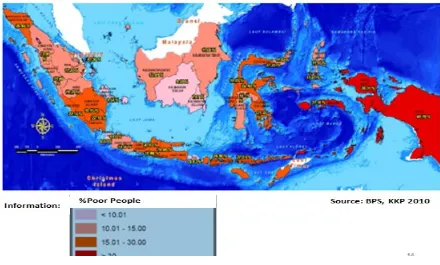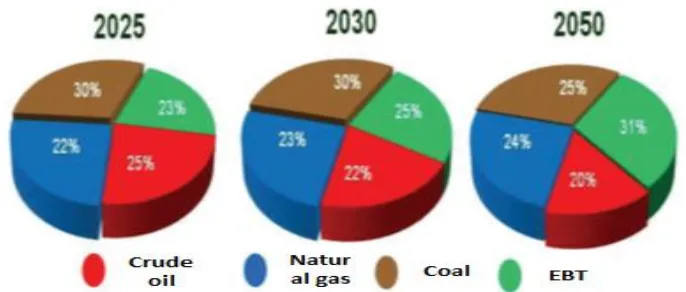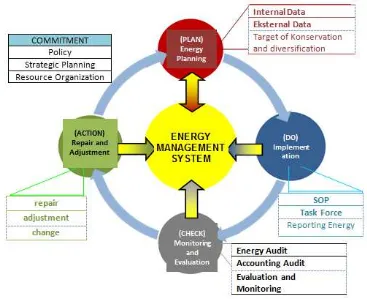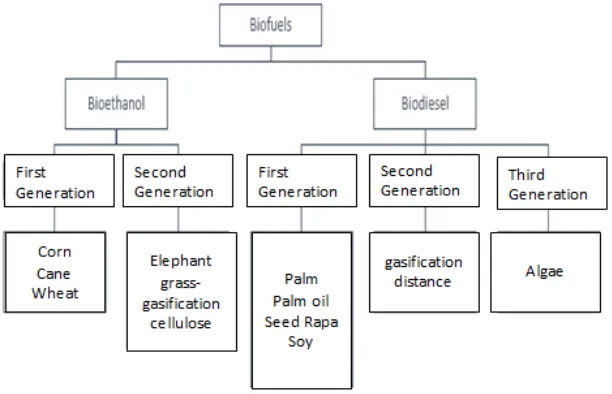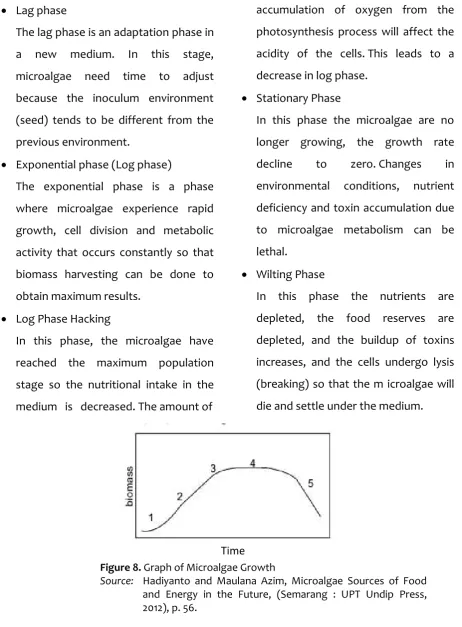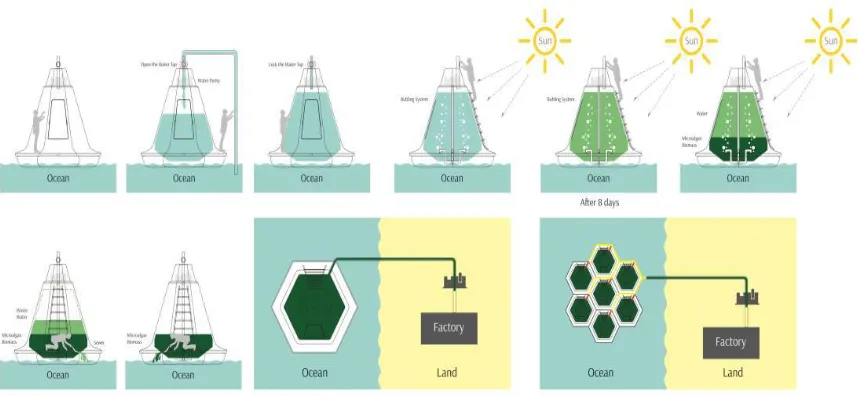Development of Energy Security to Support Maritime Defense with The ... | Khusnul Khotimah | 41
DEVELOPMENT OF ENERGY SECURITY TO SUPPORT MARITIME DEFENSE WITH
THE UTILIZATION OF MICROALGAE AS BIODIESEL FOR COASTAL
COMMUNITIES
Khusnul Khotimah1
Energy Security Study Program, Indonesia Defense University (khusnul486@gmail.com)
Abstract – Marine resources as energy resources has become one means for the construction maritime power and unifying the region's defense for Indonesia. The geographical condition of Indonesia as an archipelagic country with the vast majority of territorial waters, as well as its strategic cross-position, becomes a fundamental source for sustainable energy development through the utilization of microalgae as a potential marine plant for biodiesel fuel, a diesel mix for Indonesian coastal communities. The research method in this study uses literature study and observation of previous authors' research, which will result in an analysis of energy objectives as supporting maritime defense that includes: (1) comprehensive understanding on the management and development of marine energy resources through the use of biodiesel from renewable energy of marine microalgae; (2) raising effective awareness and cooperation among the coastal communities, government and industry regarding the greatness of Indonesian history that has been built from the control over the oceans as a source of defense in developing energy security to support maritime defense.
Keywords: maritime power, energy security, microalgae
Introduction
maritime country is a state capable of utilizing and maintaining its territory. However, the current development paradigm in Indonesia is still focused on the mainland as its defense. As a result, there is an actual inequality between the mainland and sea development, including limited capacity in utilizing the maximum potential of sea resources. Therefore, we need new concepts and strategies to build Indonesia into a strong and sovereign maritime state.
Indonesia has established maritime defense strategy, maritime wealth and maritime interests for the archipelago and has been implemented under the administration of Prseident Joko Widodo, known as GlobalMaritime Fulcrum (GMF), and it poses real challenge for both governments and communities for the management, capacity building and maintenance of energy infrastructure through the utilization of maritime sector resources1.
1 Noivong Thassarany, “Moving Beyond “Hub
42 | Journal of Defense & State Defense | April 2018, Volume 8 Number 1 The concept of maritime state is an
integral part in state defense. If the state has robust defense capacity, the state sovereignty will be protected from external threats. TNI AL (Navy) is one of the state agency that carry out the duty in safeguarding of marine areas according to the mandate of the law.2
The geographical condition of Indonesia as a maritime state, with sea territorial reaches approximately 7.9 million km 2 consisting of 3.1 million
km 2 territorial waters, 2.1 million
km 2 waters 12 miles and 2.7 million
km 2 waters of Exclusive Economy Zone
(EEZ) of Indonesia. The archipelagic character of the state has total of 40
million Indonesians population are living in coastal areas and majority are working as fishermen3, therefore the use of fuel as
energy supplies becomes an important priority to sustain the fishermen livelihood in supporting the economy.
The fuel is needed for the fishermen motor engine to operate their fishing International Studies Conference, 2011), p. 3.
2 Marsetio, Sea Power Indonesia (Jakarta:
Defense University, 2014), p. 3.
3 Pramono, Djoko, Maritime Culture, (Jakarta:
Gramedia Pustaka Utama, 2005), p. 29.
access to the coast and the rising fuel prices has increased the difficulty for fishermen so sustain their livelihood from fishing activities. The fuel cost covers 60% of total production cost for fishermen. An increase in fuel prices will increase the grass beds and also non-biological power sources (petroleum and gas and minerals
or other mining materials)5. However,
most of these resources have not been economicaaly and optimally utilized hence the coastal communities are still living in poverty.
Utilization of marine resources is aimed to meet the needs and improve community welfare. This resource development opportunity has not been
4 ESDM, Analysis Policy for Mining and Minerals:
Fisheries, Fuel Price Subsidy for Fishermen.
(Jakarta: ESDM, 2008), http: //
www.tekmira.esdm.go.id, accessed on 3
February 2018.
5 K. Kartawinata dan S. Soemodihardjo,
Biological Community in the coastal area of Indonesia. (Jakarta: Oceanology Indonesia.
Development of Energy Security to Support Maritime Defense with The ... | Khusnul Khotimah | 43 fully utilized, mainly due to the lack of
both basic and applied knowledge. In this regard, fishermen as human resources directly involved in the exploitation of marine and fishery reseources need to get a proportional attention. The fact that fishermen in Indonesia are still poorly educated, putting them in a state of poverty (Figure 1).
In such a situation, smallscale fisherfolks will always face three critical problems in their lives: (1) the struggle to meet ends for livelihood; (2) limited
ability to support their children's education needs, and (3) limited access to health insurance. With the increased utilization of marine biological resources as a source of energy, the coastal community is expected to be able to improve their welfare, by establishing business and providing job opportunity for the fulfillment of energy needs and other needs6.
The Government has launched the support to achieve EBT mix targets in national energy needs (Figure 2) where
6 Bappenas, Marine Development in the RPJMN
2015-2019, (Jakarta: Ministry of National Development Planning, 2014), p. 14
Figure 1. Map on Poverty in Coastal Communities
44 | Journal of Defense & State Defense | April 2018, Volume 8 Number 1 EBT usage reaches 25% and by 2030 and
reaches 31% by 2050.7
Therefore, this study will analyze the strategy to build understanding on the governance and development of marine energy resources from microalgae
plant into biodiesel. In addition, the creation of improved support infrastructure for the resources development is organized through effective cooperation between coastal communities, the government as the planner and policy implementer, the Navy as a maritime defense force, coastal communities and related industries to create synergistic collaboration among the nation stakeholders.
7 National Energy Council (DEN), Energy Security
Indonesia. (Jakarta:Secretary General of DEN, 2015), p. 9.
Discussion
Energy Security
The Government has issued the Government Regulation No. 79 of 2014 on National Energy Policy (KEN). This regulation has set out the vision and
mission for the development of energy security in accordance to the principles of justice, sustainable and environmentally friendly in order to create the concept of independence and national energy security (Figure 3). KEN serves as a guide and direction for national energy management to support sustainable national development8.
8 Indonesian Government Regulation, PP No. 79
on National Energy Policy, (Jakarta: The State Secretariat, 2015), p. 3.
Figure 2. Energy Mix in National Energy Policy
Development of Energy Security to Support Maritime Defense with The ... | Khusnul Khotimah | 45 Figure 3. Concept of Energy Security
Source: National Energy Council (DEN), Energy Security Indonesia, (Jakarta: Secretary General of DEN, 2015), p. 11.
Figure 4. Energy Conservation in Energy Management Systems
46 | Journal of Defense & State Defense | April 2018, Volume 8 Number 1 The National Energy Council (DEN)
through the National Energy Policy (KEN) defines energy security as a condition of ensuring the availability of energy, access to energy at affordable prices in the long term while protecting the environment sustainability9.
In realizing energy security, there needs to be an organized energy management through the principles of energy management (Figure 4).
Stages of energy management are as follows10:
1. Energy Planning includes:
a. Selection or targeting energy management objectives.
b. Determination of strategy for
objective plan:
1) Identification of situations that require energy supply;
2) Funds required; 3) Technology required; 4)Organizations required. 2. Implementation (Do) includes:
a. Program preparation consisting of: 1) Target program to be
implemented;
2) The strategy to be used;
9 National Energy Council (DEN), op.cit, p. 11.
10 Marpaung, Parlindungan, Preparation of Energy Audit Process, (Jakarta: Association of Energy Conservation Experts, 2014), p. 12.
3) Organizational structure and personnel required.
b. Implementation of the Program, consisting of:
1) Increasing awareness for optimizing the utilization of energy resources effectively and efficiently between government (Ministry of Energy and Mineral Resources, Marine, Maritime, manufactured industry and coastal community);
2) Conducting training program development with coastal communities who will directly participate in the implementation of the program;
3) Conducting a pre-defined program that has been implemented;
4)Developing guidelines, supervision and monitoring for pilot project in cooperation with relevant agencies;
5) Prepare equipment
and supporting technology. 3. Monitoring and Evaluation (Check) ,
including activities for:
a. effective and efficient energy management;
Development of Energy Security to Support Maritime Defense with The ... | Khusnul Khotimah | 47 (EBT) from the potential marine
resources.
4. Repairs and Adjustments (Action), consisting of:
a. Grade priority on monitoring and treatment results.
b. The focus of monitoring and analysis toward the implementation of fulfillment of energy needs is sufficient.
Energy resilience is a part of the national security (Figure 5 ).
The role of energy is critical because it hold significant influence within the framework of politics and government, economy, social life, and state defense and security, including
maritime defense forces11 thus with the
realization of energy security, it will
11 National Energy Council (DEN), op.cit, p. 98.
subsequently support the strength of maritime defense.
Maritime Defense
The geographical position of Indonesia is located at the world intersection between the Indian Ocean and the Pacific Ocean as well as amidst Asia and Australia, it naturally makes the territorial waters of Indonesia as one of the main lines of world trade as the Sea Lanes of
Trade (SLOT) and Sea Lanes of
Communications (SLOC). With the
constellation and geographical conditions blessed with abundant natural resources, Indonesia could potentially gain the highest benefit from its potential
resources whilst also increased the vulnerability with other countries interest
Figure 5. Energy in National Security
48 | Journal of Defense & State Defense | April 2018, Volume 8 Number 1 over the territory that may disrupt the
sovereignty, integrity, security and safety of the nation. The potential vulnerability shall be anticipated and addressed by developing nation's defense capable of facing various forms of threats during the time of peace and wartime12.
The maritime defense is a seaborne defense. In the sense of defense, Indonesia is still categorized a marine country rather than maritime. The maritime country is a country that has the ability to explore it sea potential for the state glory, whereas the marine state is merely indicating the state landscape situation, in which the said state is close to or composed of the sea13.
The strategies to build maritime defense among others are14: (a)
Establishing Indonesia's maritime mentality, behavior and maritime awareness to re-engage in a maritime-minded life by building internal and external communication network within Indonesian society, through the socio-cultural approach implementation; (b) The realization of maritime-oriented government policy by taking into account
12 Marsetio, op. c it, p. 25.
13 A. Kadar, Maritime Management Towards
Indonesia as a World Maritime Axis, (Jakarta: Nasonal Center for Security Studies of Universitas Bhayangkara Jakarta 2015), p. 426.
14 Marsetio, op.cit, p. 40.
on the perspective of all relevant institutions, that the Indonesian state is an archipelagic country, where the sea serves as the living space for people living in the archipelago through the establishment of cultural, political and economic networks in order to support maritime economic development process; (c) Realization of an integrated institution by establishing a one-stop maritime bureaucracy system, and arranging marine management to optimize maritime economic activities and significant actions taken by the ministry of marine affairs or relevant agencies to promote maritime culture; (d) Realization of the implementation and application of
optimum national marine security system through the role and duties of the Navy in supporting maritime development for a solid defense system by building strong maritime fleets to control the situation in the archipelago sea that can serve as a defense system in order to secure and maintaining the state territorial integrity; (e) management of sea transportation; (f) building a marine-based industry.
Development of Energy Security to Support Maritime Defense with The ... | Khusnul Khotimah | 49 the sea resources in a comprehensive
manner and not only focusing on physical potential so as to minimize the inequality of development within the marine sector and develop paradigm of optimal maritime defense through effective mastery and superior sea power. This status should also be strengthened with the capacity to defend itself from all threats, both within and from outside, where the maritime security capabilities is built through energy security, including optimization of marine resources15.
Potential of Microalgae
The potential of energy resources in Indonesia's vast maritime territory, such
as the microalgae plants that can be converted into biodiesel, need to be efficiently utilized in order to increase foreign exchanges rate from the marine sector as a solution to build energy security by strengthening the maritime defense to address the problem of rising microalgae cultivation land that are spread over 26 provinces in Indonesia. The potential of microalgae in Indonesia covers an area of 26,700 ha with a production potential of 462,400 tons / year16. Algae cultivation has been
practiced by coastal communities in several coastal areas such as Bali, Seribu Islands, Riau, South Sulawesi, Southeast Sulawesi, North Sulawesi and Maluku. The microalgae cultivation has been experiencing volatile situation due to erratic marketing problems.17
Traditionally algae have been exploited by coastal community as food ingredient, used for vegetables, pickles,
sweets, cakes, besides also being used as medicine18. Utilization for the industry
and as an export commodity has been growing rapidly in the last few decades. Utilization of algae for industry is mainly because of the chemical compounds content, especially carrageenan, agar, and algin. Carrageenan is a chemical that can be obtained from various types of red algae.
16 R. Dahuri, J. Rais; S.P. Ginting dan M.J. Sitepu,
Management of Coastal Resources and Marine Integrated, (Jakarta: Pradnya Paramita , 1996), p. 305.
17 Ibid., p. 308
18 A. Nontji, Sea Archipelago, (Jakarta: PT.
50 | Journal of Defense & State Defense | April 2018, Volume 8 Number 1 The significant potential for algae
cultivation should be utilized in the development of energy resilience, especially with the use of microalgae as raw material for manufacturing biodiesel as substitute of diesel. Therefore, the microalgae cultivation needs to be implemented through the coastal communities. The cultivation of microalgae can be developed in coastal areas of Indonesia such as Pangandaran Beach, Kepulauan Seribu, Bali, Samaringa Island, Telang Island, and Lampung Bay and other areas.
Mutual cooperation for microalgae cultivation by local communities is expected to boost the economy of
coastal communities and it can be center for an integrated production of biodiesel raw materials, so that it will be replicated by other regions in Indonesia and it will provide a positive social impact for maritime defense forces. Coastal communities can have the role in technical implementation as the feedstock producer for microalgae cultivation as well as users of finished products of biodiesel, which is supported with the training from government (Ministry of Energy, Ministry of Marine Affairs and Fisheries), research institutions and academics like Indonesian
Institute of Sciences (LIPI) and Agency for Assessment of Technology Development (BPPT).
The private sector is also playing an important role in the maritime economy, through the investment on microlagae utilization by providing technology and infrastructure development to optimize the utilization of marine resources, thus it can increase the local revenues and drive other sectors such as housing, transportation, commerce, SMEs and other. With this pro-government regulation, the coastal communities of Indonesia will be self-sufficient in the use of biodiesel as the main fuel for the fishermen's transportation supply.
Thus, energy development may support maritime defense, which is created through the strong collaboration between the government, the private and the public sector in converting microalgae as biodiesel with the cooperation of mutual aid in resource utilization of marine plants (Figure 6).
Microalgae are microscopic plants that use carbon dioxide as a carbon source and an organism that can grow in extreme conditions on the earth surface.
Development of Energy Security to Support Maritime Defense with The ... | Khusnul Khotimah | 51 a 3rd generation biofuels (figure 7) that
does not interfere with food stability. This type of plants is usually found in moist environment or objects that are often exposed to water and other aquatic environments on the earth surface.19
Table 1 listed some biodiesel-producing plants are a type of food plant. It is
19 Y. Chisty, op.cit, p. 303.
considered unfavorable because might lead to market competition for biodiesel against market demand for food crops. Therefore, microalgae become the right solution to be used as raw material for biodiesel manufacture, because it will not disturb the production of food plants20
20 Kawaroe et.al, Potential Microalgae and Its
Utilization for Bio Fuel Production, (Bogor: IPB Press, 2010), p. 15.
Figure 6. Roadmap on Utilization of Microalgae in Supporting Maritime Power
Figure 7. Biofuel classification based on its raw material.
52 | Journal of Defense & State Defense | April 2018, Volume 8 Number 1
Table 1. Economic Comparison of the Potential on Several Biodiesel Raw Materials Plant Oil Content (L / ha) Need of land area
(M ha)
Productivity of biodiesel (kg/ha.th)
Corn 172 1540 152
Coconut 2689 99 2315
Palm oil 5366 45 4747
Low lipid microalgae 58700 5 52927
Medium lipid microalgae 97800 3 86515
High lipid microalgae 136900 2 121104
Source:Y.Chisty, Biodiesel from microalgae, (USA: Biotechnology Advances. 2007), p. 303.
Table 2. Lipid Content of Some Microalgae Species Microalgae species Lipid's Content
(% biomass) Microalgae species
Lipid's Content (% biomass)
Chlorella emersonii 25-63 Nanochloris sp. 20-56
Chlorella minotissima 57 Nanochloropsis sp 12-53
Chlorella sp. 10-48 Schizochytrum sp. 50-77
*Chlorella vulgaris 5-58 Skelotonema
costatum
13-51
Dunaleilla salina 6-25 Pavtova salina 30
Dunaleilla primolicta 23 Pyrrosia Leavis 69
Dunaleilla sp. 17-67 Zitzschia sp. 45-47
Source:Kawaroe et.al, Microalga: Potential and Its Utilization for Bio Fuel Production, (Bogor: IPB Press, 2010), p. 15.
The most common microalgae are the Bacillariophyceae (Diatom) class, Chrysophyceae (golden brown algae), Chlorophyceae (green algae), and Cyanophyceae class (blue green algae). Based on its species in Indonesian waters, there are various forms and sizes of microalgae and the resulting lipid content
21 (Table 2).
The spread of microalgae habitats is usually in freshwater (limpoplankton) and saltwater (haloplankton), whereas the distribution based on vertical distribution in the waters includes plankton in the
21 Ibid., p. 15
euphotic zone (ephiplankton), in the disphotic zone (mesoplankton), in the aphotic zone (bathyplankton) and found in the bottom of the water or bentik
(hypoplankton).
MicroalgaeGrowth Factor
Factors affecting microalgae life are as follows22:
• Light intensity
Light is an important factor for microalgae development because it is required in the photosynthesis. The light intensity is described as unit of
Development of Energy Security to Support Maritime Defense with The ... | Khusnul Khotimah | 53 MicroEinsteins / m2s or equivalent to
one mole of photons, micromol/ m 2 s, Lux and W / m 2. The light intensity is also required depends on the volume of cultivation and density of the microalgae. The higher the density and volume of cultivation, the higher the intensity of light required. In addition to light intensity, period photographs (length it is exposed to light) also play an important role in supporting the growth of microalgae.
• Temperature
Optimal temperature for microalgae
growth is between 24-30 C but varies depending on the type of microlagae, location and composition of the media used. However, most microalgae can tolerate temperatures between 16-35 °C. Temperatures below 16 °C can slow the growth of microalgae while the into micronutrients and macronutrients. Macronutrients consists of C, H, N, P, K, S, Mg and Ca. While the micronutrients consist of Fe, Cu, Mn, Zn, Co, Mo, Bo, Vn and Si. Micronutrients used to encourage cell
growth and metabolism. Among these nutrients, N and P are often called as microalgae growth limiting factors. • Degree of acidity (pH)
Most microalgae grow at a normal pH of 6 to 8. However, some Cyanobacteria-type of microalgaes such as Spirullina plantesis can only grow in alkaline conditions while Chlorella can grow under pH conditions between 7-8.23
• Salinity
Salinity is one of the factors that affect the organism in maintaining good osmotic pressure as protoplasm organisms against water as its environment. Marine algae have great tolerance to salinity change. Optimal salinity for microalgae growth is 20-five phases: lag phase, exponential phase,
23 Hadiyanto and Maulana Azim, Microalga
Sources of Food and Energy of the
Future, (Semarang: UPT Undip Press, 2012),
54 | Journal of Defense & State Defense | April 2018, Volume 8 Number 1 log phase decline, stationary phase, and
phase of death24 (Figure 8).
• Lag phase
The lag phase is an adaptation phase in a new medium. In this stage, microalgae need time to adjust because the inoculum environment (seed) tends to be different from the previous environment.
• Exponential phase (Log phase)
The exponential phase is a phase where microalgae experience rapid growth, cell division and metabolic activity that occurs constantly so that biomass harvesting can be done to obtain maximum results.
• Log Phase Hacking
In this phase, the microalgae have reached the maximum population stage so the nutritional intake in the medium is decreased. The amount of
24 Ibid.
biomass will block the light entering into the medium, and the accumulation of oxygen from the photosynthesis process will affect the acidity of the cells. This leads to a decrease in log phase.
• Stationary Phase
In this phase the microalgae are no longer growing, the growth rate decline to zero. Changes in environmental conditions, nutrient deficiency and toxin accumulation due to microalgae metabolism can be lethal.
• Wilting Phase
In this phase the nutrients are depleted, the food reserves are depleted, and the buildup of toxins increases, and the cells undergo lysis (breaking) so that the m icroalgae will die and settle under the medium.
Time
Figure 8. Graph of Microalgae Growth
Development of Energy Security to Support Maritime Defense with The ... | Khusnul Khotimah | 55 Carbon dioxide Oxygen glucose water
MicroalgaePhotosynthesis
Microalgae is unicellular organisms that have no actual root, stems and leaves but can photosynthesize like a higher-level plant. Microalgae have chlorophyll that serves as a light catcher. It chlorophyll contains chloroplast to absorb light and then the light is used to convert simple molecules of CO2 and H2O into carbohydrates by releasing O2. During the photosynthesis, microalgae requires light intensity, nutrition and sufficient temperature25. The microalgae
photosynthesis reaction is as can be seen in Figure 9.
Microalgae Reactor Technology for
Coastal Areas
In the design of this product, there are several aspects that need to be studied to design photobioreactor that is compatible with biochemistry and
25 Ibid., p. 57.
microbiology study as well as the aspects of human centered design. These aspects include26; (1) Target user; (2) Place of
product on location; (3) Capacity of raw materials that can be accommodated; (4) Results obtained; (5) product ergonomics; (6) interactive concepts; (7) Product scenario.
Coastal areas targeted for the development of microalgae are East Coast and West Coast of Pangandaran, West Java, that has an established area of coastal community commonly used by fishermen27.
The resulting of product concept (Figure 10) is a marine microalgae culture product with a photo bioreactor type to
maximize the cultivation and harvesting of biomass, to be used in biodiesel production. This product is designed by considering the fishermen activity who become the main target of its users.
26 Amy Ardhyaksa, “Design of Microalgae
Reactor Product of Biofuel Producer for Coastal Area”, Journal of Graduate Degree of Art and Design, No.1, 2012, p. 3.
27 Ibid., hlm. 7.
6H
2O+6CO
2+light C
6H
12O
6+ 6O
2Figure 9. Reaction of microalgae photosynthesis
56 | Journal of Defense & State Defense | April 2018, Volume 8 Number 1 These considerations can be seen
from the operational scenarios of products designed to be tailored to the customs of fishermen when using their
daily equipment.28
Design selection is determined based on the suitability of the engineering aspect, the operation of the product by the user, and the output to be achieved. Some of the main components in products are: main tubes, buffer, buoys, distributor components, stairs, and road access areas. For the main tube component, transparent material becomes the main option. The goal is that light can enter the reactor to be used by
28 Ibid., p. 6.
microalgae for the process of photosynthesis.
The material chosen is High Density Polyethylene (HDPE). HDPE has
advantages over other materials such as PVC and Low-Density Polyethylene (LDPE). In addition to durable, it also has relatively low manufacturing cost. This calculation is based on comparison of usage for 20 years. Buoys using rubber materials are commonly used on inflatable boats. The access road can use fiber materials as well as for the Support component (the channel between the access components of the road and the buoy). Fiber material is considerably strong and durable. The use of fiber can be found in many fishing boats. Besides it can be easily formed, this material is easy
Figure 10. Product Operational Flow
Development of Energy Security to Support Maritime Defense with The ... | Khusnul Khotimah | 57 Table 3. Biodiesel Characteristics of Microalgae and Plants
Parameter Biodiesel mikroalgae Disel petroleum ASTM Standar
Density (kg / l) 0.864 0.838 0.86-0.90
Source : Gouveia, Luisa, Microalgae as a Feedstock for Biofuels. (Spinger brief in microbiology. 2011), p 12 and a temperature controller29.
An ergonomic and anthropometric study was conducted to determine the suitability of the product with the human physiology aspect as its user. Some operational scenarios have been identified in the product include the activity of opening the tap, opening the main door, walking on the side of the product, and climbing the stairs. This
29 Ibid., p. 5
ergonomic and anthropometric study is tailored to the predictions of user activity from beginning to end of product operation30.
Biodiesel from microalgae meets ASTM standard so it can be used as fuel mix to supply the fuel demands in Indonesia31 (Tabel 3).
Microalgae can be used as an alternative for the development of renewable energy sources to achieve energy security and potential for biodiesel feedstock. When compared to other plants and woody materials, microalgae have several advantages, such as: (1) containing oil (lipid) triglyceride as the main component of biodiesel conversion up to 70%; (2) high photosynthetic efficiency; (3) produce more biomass, faster growth; (4) not
30 Ibid.
31 Luisa Gouveia, Microalgae as a Feedstock for
Biofuels, (Heidelberg: Spinger brief in
58 | Journal of Defense & State Defense | April 2018, Volume 8 Number 1 competing against food production and
minimizing land use competition, and higher productivity; (5) can use recycled water to conserve water resources (water recycling); (6) reducing greenhouse gas emissions (co2 recycling ); (7) may use certain waste as a source of nutrients (Nitrogen (N), Phosphor (P)); (8) have side components other than lipids (proteins, and pigments having high economic value); (9) can change the co2 into biomass through photosynthesis, can survive in high salinity; (10) in accordance with the climate in Indonesia32.
Biodiesel Production
The Department of Energy (DOE), the
Environmental Protection Agency (EPA) and the American Society of Testing Materials (ASTM) define biodiesel as an alternative fuel containing triglycerides (fatty acids), derived from plant oils, animal fats or used oils through esterification with alcohol. Biodiesel can be used without re-modification of diesel engine. Biodiesel can also be written with B100, which indicates that the biodiesel is 100% pure monoalkyl ester. The mixed of biodiesel is characterized by "BXX", which "XX" represents the percentage of biodiesel composition present in the
32 Ibid., p. 14.
mixture. B20 means there are 20% biodiesel and diesel oil 80%.33
In making of biodiesel, some important variables need to be observed, such as the number of moles of alcohol (methanol/ethanol), catalyst concentration (KOH/NaOH), reaction temperature, and reaction time. The optimum amount of methanol was 20%, with 1% NaOH concentration, reaction temperature of 60 ° C with a reaction time of 90 minutes with the ester content in biodiesel by 98%. In the manufacture of biodiesel, oil is usually first improved its quality (refining) by degumming and neutralization. Degumming is done by adding phosphoric acid, while
neutralization is done by adding a NaOH base. The neutralized oil is further trans esterified with methanol or ethanol as reactants (Figure 11)34.
Regulation on testing of biodiesel is based on regulation of oil and gas
director general No.
002/P/DM/MIGAS/1979 on 25 May 1979 on the specification of fuel oil and gas and
Development of Energy Security to Support Maritime Defense with The ... | Khusnul Khotimah | 59 SNI testing standards (Indonesian
National Standard)35 that:
1) The Setana Number
For diesel motor fuel, the reference of Setana number, ie, with the normal reference material of cetane (C16 H34), which has no lit delay and methyl naphtalene aromatics (C10 H7 CH3), that has enormous delay. The Setana rate of biodiesel is at least 51, while the
standard of diesel is 48, meaning that the Setana biodiesel number is 1.05 lower than diesel. But the number of Setana from biodiesel produced is still included in the standard range of biodiesel that is at least 51. From the number of Setana biodiesel that is 51 it can be classified as fast diesel engine on cetane number 40 to 70. The higher
35 Ahmad Budi Junaidi, Study on Biodiesel
Production and Bioethanol Based on Simultaneous Microalgae, (Banjarbaru: FMIPA UNLAM, 2012), p. 6.
the number of the setana means the lower the point of ignition.
2) Kinematic Viscosity
Standard Kinematic viscosity of biodiesel is of 2.3 cSt to 6 cSt. If the price of the viscosity is too high, then the friction loss in the pipeline will be great, the pump work will be heavy, the filtration is difficult and the possibility of dirt to be deposited is large, and it’s going to be difficult to disregard the fuel. Conversely, if the viscosity is too low resulting in a thin lubrication, if left continuously it will result in wear and tear.
3) Spesific Gravity
Specific gravity of biodiesel is still in the range of diesel between 0.82 to 0.95. From specific gravity testing at 600 F this can also be specified oAPI. 4)Calorific Value
The standard minimum of calorie generated by biodiesel is 17.65 Btu/lb.
Figure 11. The reaction of the formation of an alkyl ester compound (biodiesel)
60 | Journal of Defense & State Defense | April 2018, Volume 8 Number 1
Table4. Quality requirements of biodiesel according to SNI-04-7182-2006
Parameters and units Value limit Test method
Mass type at 40 0C, kg/m3 850-890 ASTM D 1298
Kinematic viscosity at 40 0 C, mm2/s (cSt) 2,3-6,0 ASTM D 445
Cetane number Min. 51 ASTM D 613
Flash point (closed bowl, 0 C Min. 100 ASTM D 93
Fog point, 0 C Max. 18 ASTM D 2500
Corrosion of copper strip (3 hours, 50 0 C) Max. No. 3 ASTM D 130 Carbon residue, % weight:
- in the original example Max. 0,05 ASTM D 4530
- in 10% distillation residue Max. 0,03
Water and sediment, % -volume Max. 0,05 ASTM D 2709
Distillation temperature 90%,0 C Max. 360 ASTM D 1160
Ash sulfated, % -weight Max. 0,02 ASTM D 874
Sulfur, ppm-b (mg / kg) Max. 100 ASTM D 5453
Phosphorus, ppm-b (mg / kg) Max. 10 AOCS Ca 12-55
Acid number, mg-KOH / g Max. 0,8 AOCS Cd 3-63
Gliserol-bebas, %-berat Max. 0,02 AOCS Ca 14-56
Glycerol-free, % -weight Max. 0,24 AOCS Ca 14-56
Levels of alkyl esters, % -weight Min. 96,5 Calculated
Number of iodine, gI 2 / (100 g) Max. 115 AOCS Cd 1-25
Halphen Test Negative AOCS Cb 1-25
Source: Ahmad Budi Junaidi, Study on Biodiesel Production and Bioethanol Based on Simultaneous Microorganisms, (Banjarbaru: FMIPA UNLAM, 2012), p. 11.
The advantages of using biodiesel include: (a) biodiesel has characteristics similar to that of diesel oil, so it can be directly used on diesel motors without significant modification with very little damage risk; (b) biodiesel provides a
better lubrication effect than conventional diesel oil. Even one percent increase in biodiesel can increase lubrication by nearly 30 percent; (c) biodiesel can be renewed and its closed carbon cycle does not cause global warming. The lifecycle analysis shows that overall CO2 emissions are reduced by
78% compared to diesel engines that use petroleum fuel36.
As a fuel, biodiesel must meet the requirements set by SNI (Table 4).
Conclusion
Energy as a supporter for maritime defense forces that include: (1) a sound understanding of the management and development of marine energy resources through the use of biodiesel as a renewable energy of marine microalgae; (2) have the ability and awareness to create and improve the infrastructure
Development of Energy Security to Support Maritime Defense with The ... | Khusnul Khotimah | 61 supporting the development of marine
resources through effective cooperation between coastal communities, government and industry in mutual cooperation.
Suggestion
Matters to note: (a) The need for effective cooperation among relevant ministries to support maritime defense; (b) The need for the principle of energy as defense supporting in the future that
various regions, unlike other biofuel feedstocks such as soybeans, sunflower, castor oil and palm oil that can only be developed in certain areas and for quite a long time with a large growth area.
References
Books
Bappenas. 2014. Marine Development in RPJMN 2015-2019. Jakarta: Ministry of National Development Planning. Chisty, Y. 2007. Biodiesel from microalgae.
USA: Biotechnology Advances. Dahuri, R.; J. rais; S. P. Ginting and M.J.
Sitepu. 1996. Integrated coastal and
marine resource management.
Jakarta: Pradnya Paramita.
National Energy Council (DEN). 2015. Energy Security Indonesia. Jakarta: Secretary General of DEN.
Geoffrey Till. 2008. Seapower: A Guide for the Twenty-First Century. (Cass Series: Naval Policy and History). London: Third Edition Routledge for IISS Adelphi Books.
Gouveia, Luisa. 2011. Microalgae as a Feedstock for Biofuels. Heidelberg: Spinger brief in microbiology.
Junaidi, Ahmad Budi. 2012. Study on Biodiesel Production and Bioethanol Based on Microalga Simultaneously. Banjarbaru: FMIPA UNLAM.
Kadar, A. 2015. Maritime Management Towards Indonesia as a World Maritime Axis. Jakarta: Nasonal Security Studies Center of Universitas Bhayangkara Jakarta. Kartawinata, K. dan S. Soemodihardjo.
1977. Biological Community in Coastal
Area of Indonesia. Jakarta:
Oceanology Indonesia.
Kawaroe et.al. 2010. Potential Microalgae and Its Utilization for Bio Fuel Production. Bogor: IPB Press.
Marsetio. 2014. Sea archipelago Indonesia. Jakarta: UNHAN.
Nontji, A. 1987. Laut Nusantara. Jakarta: PT. Jambatan.
Pramono, Djoko. 2005. Maritime Culture. Jakarta: Gramedia Pustaka Utama PT. Energy Management Indonesia
(Persero). 2011. Introduction to
Energy Management. Jakarta:
Ministry of Industry.
Journals
62 | Journal of Defense & State Defense | April 2018, Volume 8 Number 1
Journal of Graduate Degree of Art and Design . Number 1
Legislations
Government of the Republic of Indonesia. 2014. Government Regulation No. 79 of 2014 on National Energy Policy. Jakarta: State Secretariat
Websites
ESDM. 2008. Analysis Policy for Mining and Minerals: Fisheries, Fuel Price Subsidy for fishermen. Jakarta: ESDM, http://www.tekmira.esdm.go.id, accessed on 3 February 2018
Ministry of Marine Affairs and Fisheries Indonesia. 2011. Profile and Indonesia Marine Potential. Jakarta: Ministry of Marine
Affairs, http://pusatkelautandanperi kanan.wordpress.com,
accessed onJanuary 20, 2018
Proceedings
Noivong, Thassarany. 2011. Moving Beyond Hub-and-Spokes System: US – ASEAN
Non-Traditional Security and
Multilateral Cooperation. Portugal: Third Global International Studies Conference.
